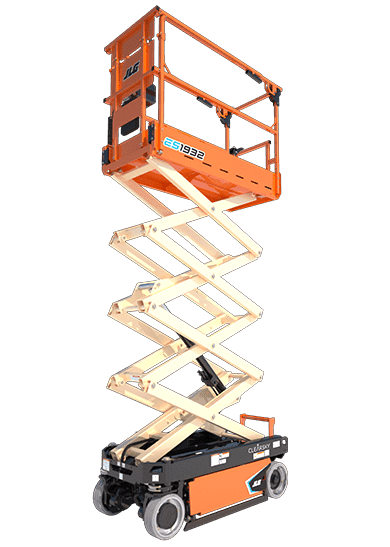Scissor Lift Rentals
Electric and Rough Terrain Scissor Lifts for Outdoor and Indoor Work

Scissor Lift Specifications and Rates
We offer a wide range of scissor lift rentals to meet the needs of any job site.
| Equipment | Daily | Weekly | Monthly |
|---|---|---|---|
| 12′ – Specs | $110 | $250 | $550 |
| 15′ – Specs | $110 | $250 | $550 |
| 19′ – Specs | $115 | $275 | $650 |
| 26′ – Specs | $165 | $375 | $795 |
| 32′ – Specs | $185 | $395 | $1,200 |
| 40′ – Specs | $250 | $575 | $1,750 |
| Equipment | Daily | Weekly | Monthly |
|---|---|---|---|
| 12′ – Specs | call for rates | call for rates | call for rates |
| 15′ – Specs | call for rates | call for rates | call for rates |
| 19′ – Specs | call for rates | call for rates | call for rates |
| 26′ – Specs | call for rates | call for rates | call for rates |
| 32′ – Specs | call for rates | call for rates | call for rates |
| 40′ – Specs | call for rates | call for rates | call for rates |
| Rough Terrain | Daily | Weekly | Monthly |
|---|---|---|---|
| 26′ – Specs | call for rates | call for rates | call for rates |
| 33′ – Specs | call for rates | call for rates | call for rates |
| 40′ – Specs | call for rates | call for rates | call for rates |
| 50' - Specs | call for rates | call for rates | call for rates |
Find the Right Scissor Lift for Your Project
Our fleet includes a variety of sizes and models to suit the needs of any project, from small electric scissor lifts for indoor use to larger rough terrain models for outdoor work
Looking to purchase a Scissor Lift? Give us a call at (951) 471-2127 for more information.
Frequently Asked Questions
-
Should I use a scissor lift or a boom lift?
Deciding between a scissor lift and a boom lift depends on the specific needs of your project. Here are a few factors to consider:
- Height: Scissor lifts are designed for vertical lifting and are typically best suited for working at heights up to around 40 feet. Boom lifts, on the other hand, are designed for reaching higher heights and can extend up to around 250 feet. If you need to work at a height greater than 40 feet, a boom lift might be the better choice.
- Working surface: Scissor lifts are generally more stable than boom lifts and are better suited for working on flat, even surfaces. Boom lifts, on the other hand, are more maneuverable and can be used on rough or uneven terrain.
- Load capacity: Both scissor lifts and boom lifts have different load capacities, so it's important to consider the weight of the materials you'll be lifting. Scissor lifts typically have a higher load capacity, while boom lifts have a lower capacity but can reach higher heights.
- Reach: If you need to reach over obstacles or into tight spaces, a boom lift might be the better choice. Scissor lifts have a more limited reach, but can be more stable for working at lower heights.
Ultimately, the decision between a scissor lift and a boom lift will depend on the specific needs and requirements of your project. If you are unsure whether to use a scissor lift or a boom lift for your project, contact our team and we will help determine the most appropriate equipment for your needs.
-
Do I need to be certified to use a scissor lift?
In some cases, yes, you will need to be certified to use a scissor lift. In most cases, the only requirement is a saftey training course.
Scissor lifts are classified as aerial work platforms, which are considered powered industrial trucks under Occupational Safety and Health Administration (OSHA) regulations.
-
Do I need a rough terrain scissor lift?
Rough terrain scissor lifts are designed for use in outdoor environments where the ground is uneven or unstable. These lifts are equipped with four-wheel drive and rugged tires that allow them to navigate over rough terrain and uneven surfaces.
You may need to use a rough terrain scissor lift if you are working on a construction or landscaping project in an outdoor setting and need to access elevated areas that are not on a flat, stable surface. Some examples of situations where a rough terrain scissor lift might be useful include:
- Working on a hillside or slope
- Accessing a job site that is not paved or has uneven ground
- Working in muddy or wet conditions
- Working on a job site with loose debris or debris that could damage regular tires
It's important to note that rough terrain scissor lifts are not suitable for all job sites. If you are unsure whether a rough terrain scissor lift is the right choice for your project, contact our team and we will help determine the most appropriate equipment for your needs.
Want Us To Call You?
Fill in your information and we will give you a call.
Contact Us
We will get back to you as soon as possible.
Please try again later.
By contacting us, you agree to be contacted via SMS and phone. Standard messaging rates may apply. You can opt-out at any time by replying STOP to any SMS received.







